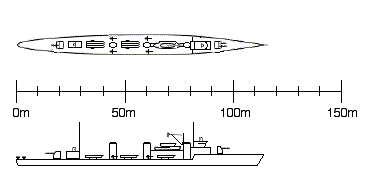|
Most modern Russian destroyers in service are 24 Orphey class, laid down 1915, serving in Northern
Fleet. Oldest destroyers are 24 Becharskiy Class, laid down 1904, serving in Baltic and Black Sea Feets. Government of Russian
Federation are considering laying down new class of Destroyers, named after cities in Russian Federation. Tashkent class will
begin standardization of Russian destroyer armament on 130mm main gun.

|
|
Tashkent Class, Russia Destroyer laid down 1921
Displacement:
1,446 t light; 1,496
t standard; 1,652 t normal; 1,771 t full load
Loading submergence 206 tons/feet
Dimensions:
377.30 ft x 32.81
ft x 10.50 ft (normal load)
115.00 m x 10.00 m x 3.20 m
Armament:
3 - 5.12" / 130 mm guns
4 - 1.46" /
37 mm AA guns
4 - 0.50" / 13 mm guns
Weight of broadside 208 lbs / 94 kg
9 - 21.0" / 533 mm above water torpedoes
50 tons depth charges/mines
Machinery:
Oil fired boilers, steam turbines,
Geared drive, 2 shafts, 39,099
shp / 29,168 Kw = 33.50 kts
Range 3,200nm at 15.00 kts
Complement:
129 - 168
Cost:
£0.510 million
/ $2.039 million
Distribution of weights at normal displacement:
Armament: 26 tons, 1.6 %
Machinery: 913 tons,
55.3 %
Hull, fittings & equipment: 457 tons, 27.6 %
Fuel, ammunition & stores: 207 tons, 12.5 %
Miscellaneous
weights: 50 tons, 3.0 %
Metacentric height 1.6
Remarks:
Caution: Hull subject to strain in open-sea
Hull
space for machinery, storage & compartmentation is cramped
Room for accommodation & workspaces is cramped
Ship
has slow, easy roll, a good, steady gun platform
Good seaboat, rides out heavy weather easily
Estimated overall
survivability and seakeeping ability:
Relative margin of stability: 1.34
Shellfire needed to sink: 398 lbs / 181 Kg
= 5.9 x 5.1 " / 130 mm shells
(Approx weight of penetrating shell hits needed to sink ship excluding critical hits)
Torpedoes
needed to sink: 0.3
(Approx number of typical torpedo hits needed to sink ship)
Relative steadiness as gun platform:
70 %
(Average = 50 %)
Relative rocking effect from firing to beam: 0.21
Relative quality as seaboat: 1.21
Hull
form characteristics:
Block coefficient: 0.445
Sharpness coefficient: 0.30
Hull speed coefficient 'M': 9.75
'Natural
speed' for length: 19.42 kts
Power going to wave formation at top speed: 65 %
Trim: 58
(Maximise stabilty/flotation
= 0, Maximise steadiness/seakeeping = 100)
Estimated hull characteristics & strength:
Underwater volume absorbed
by magazines and engineering spaces: 193.5 %
Relative accommodation and working space: 81.0 %
(Average = 100%)
Displacement
factor: 56 %
(Displacement relative to loading factors)
Relative cross-sectional hull strength: 0.50
(Structure
weight / hull surface area: 33 lbs / square foot or 161 Kg / square metre)
Relative longitudinal hull strength: 1.03
(for
15.26 ft / 4.65 m average freeboard, freeboard adjustment 4.69 ft)
Relative composite hull strength: 0.54
|



